
 |
http://people.csail.mit.edu/jaffer/FreeSnell/metallic.html |
FreeSnell: Metal Films | |
FreeSnell is a program to compute optical properties of multilayer thin-film coatings.
This validation suite is from "metallic.scm", part of the FreeSnell package. "metallic.log" is the text generated by running metallic.scm:
scm -l metallic.scm > metallic.log
These designs use metal for reflection; the metal is arbitrarily thick.
"Protected Aluminum Mirror" from JK Consulting. Gray is untreated aluminum.
| JK Consulting | |
|---|---|
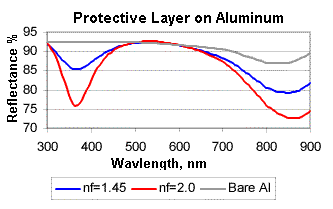 | |

| |
| FreeSnell | |
| JK Consulting | |
|---|---|
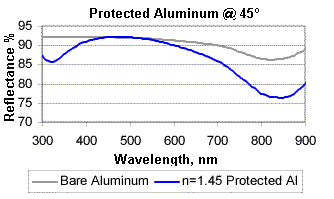 | |

| |
| FreeSnell | |
"Enhanced Aluminum Mirror" from JK Consulting. Gray is untreated aluminum.
| JK Consulting | |
|---|---|
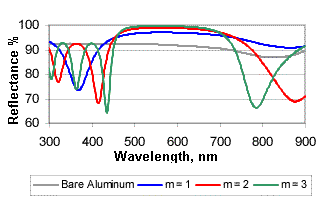 | |

| |
| FreeSnell | |
"Aluminum Mirror (/016)" from Melles Griot Reflectance from untreated aluminum.
| Melles Griot | |
|---|---|
 | |

| |
| FreeSnell | |
The reflectance in the Melles Griot plot reaches a minimum at 800.nm; but the minimum in the FreeSnell plot occurs at a longer wavelength, 827.nm. This difference survives restriction to Sopra data or restriction to CRC data.
Interpolation is turned off in the closeup plots below. Although n and k/n reach local maximum and minimum at 800.nm, k (886.nm) and the reflectance (827.nm) do not. Checking against the Sopra and CRC data confirm these locations. The CRC aluminum data includes a normal reflectance column, which reaches its local minimum at 827.nm (1.5.eV). With agreement between CRC and Sopra data, this difference with Melles Griot does not indict FreeSnell; perhaps the deposited aluminum has nk values different from the bulk metal.

"Si2O3 Protected Aluminum (/011)" from Melles Griot shows the performance of their coated aluminum surfaces 0 and 45 degree angles of incidence. The slight mismatch is probably due to the difference in aluminum nk values hypothesized above.
| Melles Griot | |
|---|---|
 | |

| |
| FreeSnell | |
"Gold Mirror (/45)" from Melles Griot Reflectance from untreated gold.
| Melles Griot | |
|---|---|
 | |

| |
| FreeSnell | |
In "Metal-Dielectric Bandpass Filter" from Software Spectra, Inc.'s TFCalc program the dielectric materials (BK7, SiO2, and TiO2) are given fixed indexes of refraction; the gold uses parameters from the NK database. A marker on the FreeSnell plot shows the location of the TFCalc peak.
| TFCalc | |
|---|---|
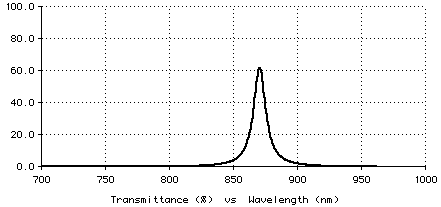 | |

| |
| FreeSnell | |
"Metal-Dielectric Dual Bandpass Filter" from Software Spectra, Inc.'s TFCalc program also shows good match with FreeSnell. The dielectric materials (BK7, SiO2, and TiO2) are given fixed indexes of refraction; the gold uses parameters from the nk database. Markers on the FreeSnell plot show the locations of the TFCalc peaks.
| TFCalc | |
|---|---|
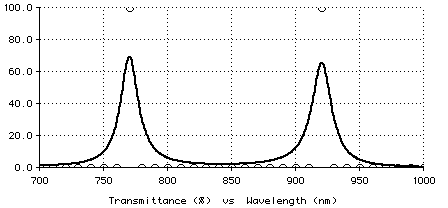 | |

| |
| FreeSnell | |
The Software Spectra web pages for these two designs do not detail the refractive indexes used; the fixed n values were determined empirically. In both these cases, using the Sopra/CRC database for the dielectric materials shifts the peaks to much longer wavelengths. Using fixed nk values for the gold film produces broader and lower peaks. The TFCalc program comes with Sopra data repackaged in a different format. Spot checks find its AU.MAT in alignment with Sopra's au.nk.

John Simpson's Multi-layer interference coatings 2002 US Patent 6,399,228 (GB 1996 Patent 9619781) gives a reflectance graph for a 6 nm chromium film sandwiched between MgF2 on a silver substrate. The structure will have the deep blue color shown to the right.
(optical-stack
(layer MgF2 320e-9)
(layer Cr 6e-9)
(layer MgF2 320e-9)
(substrate Ag))
| United States Patent: 6,399,228 Fig. 6. | |
|---|---|

| |

| |
| FreeSnell | |
Reproducing the data generated by other programs is useful; but fidelity with measured data is the ultimate goal of an optical analysis program.
The graph from Fan and Bachner's 1982 "Transparent heat-mirror" patent 4,337,990 provides measured data for a transparent heat-mirror formed from a 18.nm metallic silver layer sandwiched between 18.nm titanium dioxide layers and placed on a 1.mm thick substrate of Corning No. 7059 glass.
Running this configuration directly results in a hash of internal reflections from the 1.mm thick substrate. Why is the patent's graph smooth?
Spectrography equipment is not infinitely precise. A number of factors, from aperture size to sweep speed, smooth peaks and valleys and reduce slope of recorded curves. Such Video filtering can remove oscillatory artifacts. The archetypal linear filter is the Gaussian filter. The middle computed curve is convolved with a Gaussian filter with a sigma of 0.025.um by adding the parameter (smooth 0.025e-6). FreeSnell's graph is limited to 2.um because the Sopra database has no mid-infrared data for glasses.
| United States Patent: 4,337,990 Figure 2. | |
|---|---|

| |
 | |
 | |
| FreeSnell | |
 The FreeSnell rendition does not match in the ultraviolet range. A
kink in Sopra's TiO2 index of refraction data, shown above, is the
proximate cause.
The FreeSnell rendition does not match in the ultraviolet range. A
kink in Sopra's TiO2 index of refraction data, shown above, is the
proximate cause.
To the right are the colors of transmission through and reflection from the hot mirror.
| United States Patent: 4,337,990 Figure 4. | |
|---|---|
 | |

| |
| FreeSnell | |
Although not a metal, ZnS is also not dielectric at visual wavelengths. It is included here for lack of a better place.
Table 7.7 of [Heavens] citing M. Banning gives a table describing the colors of zinc sulfide deposited on glass. The table is shown here together with the reflected colors which FreeSnell computes at 0° and 45° angles of incidence:
| FreeSnell 0° 45° | Optical thickness (at 546.1.nm) | ZnS | Cryolite |
|---|---|---|---|

| Bluish-white | yellow | |
| 1/4 | White | magenta | |
| Greenish-yellow | blue | ||
| 1/2 | Magenta | white | |
| Blue | yellow | ||
| 3/4 | Greenish-white | magenta | |
| Yellow | blue | ||
| 4/4 | Magenta | greenish white |
The colors match the descriptions fairly well.
The next section tests FreeSnell's modeling of granular films.
|
I am a guest and not a member of the MIT Computer Science and Artificial Intelligence Laboratory.
My actions and comments do not reflect in any way on MIT. | ||
| FreeSnell | ||
| agj @ alum.mit.edu | Go Figure! | |